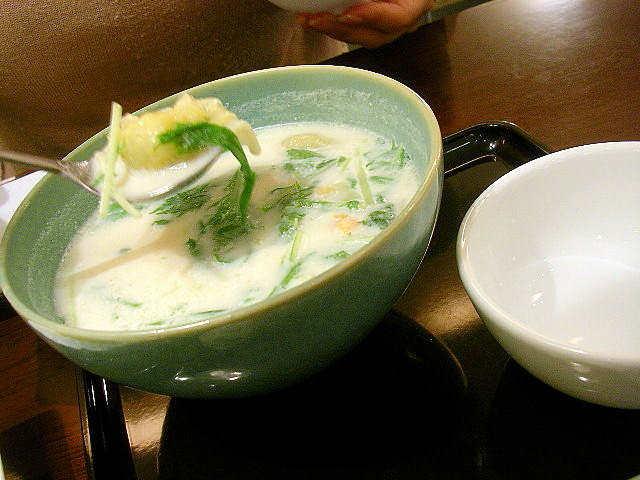|
Kongguksu
''Kong-guksu'' * () or noodles in cold soybean soup is a seasonal Korean noodles, Korean noodle dish served in a cold soy milk broth. In the Korean language, kong means soybean and guksu means noodles. It comprises noodles made with wheat flour and soup made from ground soybeans. It is unknown when Korean people started eating ''kongguksu''; however, in accordance with the mention of the dish along with ''kkaeguksu'' (깨국수, sesame noodle soup) in ''Siui jeonseo'', a Joseon Dynasty, Joseon cookbook published around the late 19th century, it is presumed to have originated at least as early as the 19th century. See also * Korean cuisine * Naengmyeon * Kalguksu References External links Kongguksu recipeSoy Milk Noodle Soup (Kongguksu) 콩국수* [ Kongguksu recipe] at JoongAng Ilbo, Patzzi Kong guksu recipe {{Soups Korean noodle dishes Noodle soups Soy-based foods Cold noodles ... [...More Info...] [...Related Items...] OR: [Wikipedia] [Google] [Baidu] |
Korean Cuisine
Korean cuisine has evolved through centuries of social and political change. Originating from ancient agricultural and nomadic traditions in Korea and southern Manchuria, Korean cuisine reflects a complex interaction of the natural environment and different cultural trends. Korean cuisine is largely based on rice, vegetables, seafood and (at least in South Korea) meats. Dairy is largely absent from the traditional Korean diet. Traditional Korean meals are named for the number of side dishes (반찬; 飯饌; '' banchan'') that accompany steam-cooked short-grain rice. Kimchi is served at nearly every meal. Commonly used ingredients include sesame oil, ''doenjang'' (fermented bean paste), soy sauce, salt, garlic, ginger, '' gochugaru'' ( pepper flakes), ''gochujang'' (fermented red chili paste) and napa cabbage. Ingredients and dishes vary by province. Many regional dishes have become national, and dishes that were once regional have proliferated in different variat ... [...More Info...] [...Related Items...] OR: [Wikipedia] [Google] [Baidu] |
Korean Noodles
Korean noodles are noodles or noodle dishes in Korean cuisine, and are collectively referred to as ''"guksu"'' in native Korean or ''"myeon"'' in hanja character. Preparations with noodles are relatively simple and dates back to around BC 6000 to BC 5000 in Asia. In Korea, traditional noodle dishes are ''onmyeon'' (beef broth-based noodle soup), called ''guksu jangguk'' (noodles with a hot clear broth), '' naengmyeon'' (cold buckwheat noodles), '' bibim guksu'' (cold noodle dish mixed with vegetables), ''kalguksu'' (knife-cut noodles), ''kongguksu'' (noodles with a cold soybean broth) among others. In royal court, ''baekmyeon'' (literally "white noodles") consisting of buckwheat noodles and pheasant broth, was regarded as the top quality noodle dish. ''Naengmyeon'', with a cold soup mixed with dongchimi (watery radish kimchi) and beef brisk broth, was eaten in court during summer. Noodles by ingredients * Dangmyeon (당면; cellophane noodles) - made from sweet potato starch ... [...More Info...] [...Related Items...] OR: [Wikipedia] [Google] [Baidu] |
Kong-guksu Made From Paju Jangdan Beans
''Kong-guksu'' * () or noodles in cold soybean soup is a seasonal Korean noodle dish served in a cold soy milk broth. In the Korean language, kong means soybean and guksu means noodles. It comprises noodles made with wheat flour and soup made from ground soybeans. It is unknown when Korean people started eating ''kongguksu''; however, in accordance with the mention of the dish along with ''kkaeguksu'' (깨국수, sesame noodle soup) in ''Siui jeonseo'', a Joseon cookbook published around the late 19th century, it is presumed to have originated at least as early as the 19th century. See also * Korean cuisine * Naengmyeon * Kalguksu ''Kal-guksu'' * (; ; ) is a Korean noodle dish consisting of handmade, knife-cut wheat flour noodles served in a large bowl with broth and other ingredients. It is traditionally considered a seasonal food, consumed most often in summer. Its ... References External links Kongguksu recipeSoy Milk Noodle Soup (Kongguksu) 콩국수* ... [...More Info...] [...Related Items...] OR: [Wikipedia] [Google] [Baidu] |
Soybean Soup
Soy milk (simplified Chinese: 豆浆; traditional Chinese: 豆漿) also known as soya milk or soymilk, is a plant-based drink produced by soaking and grinding soybeans, boiling the mixture, and filtering out remaining particulates. It is a stable emulsion of oil, water, and protein. Its original form is an intermediate product of the manufacture of tofu. Originating in China, it became a common beverage in Europe and North America in the latter half of the 20th century, especially as production techniques were developed to give it a taste and consistency more closely resembling that of dairy milk. Soy milk may be used as a substitute for dairy milk by individuals who are vegan or are lactose intolerant. Soy milk is also used in making imitation dairy products such as soy yogurt, soy cream, soy kefir and soy-based cheese analogues. It is also used as an ingredient for making milkshakes, pancakes, smoothies, bread, mayonnaise, and baked goods. Names In China, the usual te ... [...More Info...] [...Related Items...] OR: [Wikipedia] [Google] [Baidu] |
Soy Milk
Soy milk (simplified Chinese: 豆浆; traditional Chinese: 豆漿) also known as soya milk or soymilk, is a plant-based drink produced by soaking and grinding soybeans, boiling the mixture, and filtering out remaining particulates. It is a stable emulsion of oil, water, and protein. Its original form is an intermediate product of the manufacture of tofu. Originating in China, it became a common beverage in Europe and North America in the latter half of the 20th century, especially as production techniques were developed to give it a taste and consistency more closely resembling that of dairy milk. Soy milk may be used as a substitute for dairy milk by individuals who are vegan or are lactose intolerant. Soy milk is also used in making imitation dairy products such as soy yogurt, soy cream, soy kefir and soy-based cheese analogues. It is also used as an ingredient for making milkshakes, pancakes, smoothies, bread, mayonnaise, and baked goods. Names In China, the usual ter ... [...More Info...] [...Related Items...] OR: [Wikipedia] [Google] [Baidu] |
Korea
Korea ( ko, 한국, or , ) is a peninsular region in East Asia. Since 1945, it has been divided at or near the 38th parallel, with North Korea (Democratic People's Republic of Korea) comprising its northern half and South Korea (Republic of Korea) comprising its southern half. Korea consists of the Korean Peninsula, Jeju Island, and several minor islands near the peninsula. The peninsula is bordered by China to the northwest and Russia to the northeast. It is separated from Japan to the east by the Korea Strait and the Sea of Japan (East Sea). During the first half of the 1st millennium, Korea was divided between three states, Goguryeo, Baekje, and Silla, together known as the Three Kingdoms of Korea. In the second half of the 1st millennium, Silla defeated and conquered Baekje and Goguryeo, leading to the "Unified Silla" period. Meanwhile, Balhae formed in the north, superseding former Goguryeo. Unified Silla eventually collapsed into three separate states due to ... [...More Info...] [...Related Items...] OR: [Wikipedia] [Google] [Baidu] |
Cookbook
A cookbook or cookery book is a kitchen reference containing recipes. Cookbooks may be general, or may specialize in a particular cuisine or category of food. Recipes in cookbooks are organized in various ways: by course (appetizer, first course, main course, dessert), by main ingredient, by cooking technique, alphabetically, by region or country, and so on. They may include illustrations of finished dishes and preparation steps; discussions of cooking techniques, advice on kitchen equipment, ingredients, and substitutions; historical and cultural notes; and so on. Cookbooks may be written by individual authors, who may be chefs, cooking teachers, or other food writers; they may be written by collectives; or they may be anonymous. They may be addressed to home cooks, to professional restaurant cooks, to institutional cooks, or to more specialized audiences. Some cookbooks are didactic, with detailed recipes addressed to beginners or people learning to cook particular dishes o ... [...More Info...] [...Related Items...] OR: [Wikipedia] [Google] [Baidu] |
Noodle Soups
Noodles are a type of food made from unleavened dough which is either rolled flat and cut, stretched, or extruded, into long strips or strings. Noodles are a staple food in many cultures (for example, Chinese noodles, Filipino noodles, Indonesian noodles, Japanese noodles, Korean noodles, Vietnamese noodles, and Italian pasta) and made into a variety of shapes. While long, thin strips may be the most common, many varieties of noodles are cut into waves, helices, tubes, strings, or shells, or folded over, or cut into other shapes. Noodles are usually cooked in boiling water, sometimes with cooking oil or salt added. They are often pan-fried or deep-fried. Noodles are often served with an accompanying sauce or in a soup. Noodles can be refrigerated for short-term storage or dried and stored for future use. Etymology The word for noodles in English, was borrowed in the 18th century from the German word ''Nudel''. History Origin The earliest written record of noodles is ... [...More Info...] [...Related Items...] OR: [Wikipedia] [Google] [Baidu] |
Korean Noodle Dishes
Korean may refer to: People and culture * Koreans, ethnic group originating in the Korean Peninsula * Korean cuisine * Korean culture * Korean language **Korean alphabet, known as Hangul or Chosŏn'gŭl **Korean dialects and the Jeju language **See also: North–South differences in the Korean language Places * Korean Peninsula, a peninsula in East Asia * Korea, a region of East Asia * North Korea, the Democratic People's Republic of Korea * South Korea, the Republic of Korea Other uses * Korean Air, flag carrier and the largest airline of South Korea See also *Korean War, 1950–1953 war between North Korea and South Korea *Names of Korea, various country names used in international contexts *History of Korea The Lower Paleolithic era in the Korean Peninsula and Manchuria began roughly half a million years ago. Christopher J. Norton, "The Current State of Korean Paleoanthropology", (2000), ''Journal of Human Evolution'', 38: 803–825. The earlies ..., the history of Ko ... [...More Info...] [...Related Items...] OR: [Wikipedia] [Google] [Baidu] |
JoongAng Ilbo
''The JoongAng'', formally known as ''JoongAng Ilbo'', is a South Korean daily newspaper published in Seoul, South Korea. It is one of the three biggest newspapers in South Korea, and a newspaper of record for South Korea. The paper also publishes an English edition, '' Korea JoongAng Daily'', in alliance with the ''International New York Times''. It is often regarded as the holding company of JoongAng Group chaebol as it is owner of various affiliates, such as the broadcast station and drama producing company JTBC, and movie theatres chain Megabox. History It was first published on September 22, 1965, by Lee Byung-chul, the founder of Samsung Group which once owned the Tongyang Broadcasting Company (TBC). In 1980, ''JoongAng Ilbo'' gave up TBC and TBC merged with KBS. ''JoongAng Ilbo'' is the pioneer in South Korea for the use of horizontal copy layout, topical sections, and specialist reporters with investigative reporting teams. Since April 15, 1995, ''JoongAng Ilbo'' h ... [...More Info...] [...Related Items...] OR: [Wikipedia] [Google] [Baidu] |
Kalguksu
''Kal-guksu'' * (; ; ) is a Korean noodle dish consisting of handmade, knife-cut wheat flour noodles served in a large bowl with broth and other ingredients. It is traditionally considered a seasonal food, consumed most often in summer. Its name comes from the fact that the noodles are not extruded or spun, but cut.Kalguksu at History The record of noodles can be found in documents of the era, but the descriptions are vague and the nature of the noodles isn't clear. In the 12th century document ''Goryeo dogyeong'' (; Hanja: 高麗圖經) it ...[...More Info...] [...Related Items...] OR: [Wikipedia] [Google] [Baidu] |






